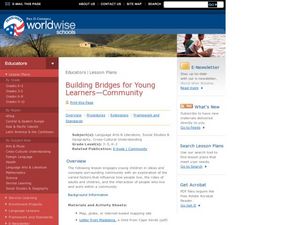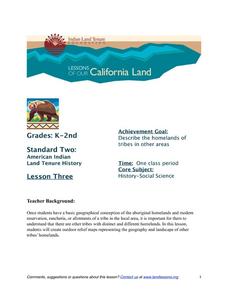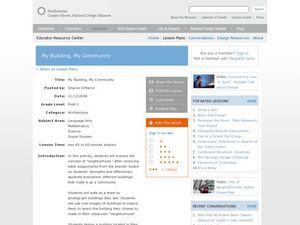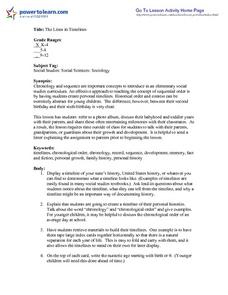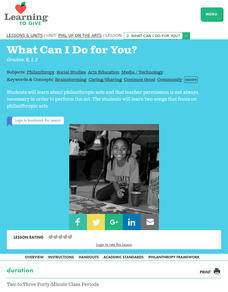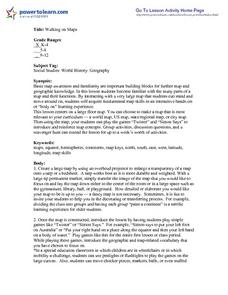Curated OER
Portrait of a Hero
Students examine the concept and characteristics of a hero. They brainstorm and categorize a list of heroes, develop a chart checklist, discuss real-life heroes, and create a hero hall of fame display.
Curated OER
Providing Service for a Nonprofit
Students participate in a non-profit organization. In this citizenship activity, students volunteer at a non-profit organization and apply the concept of philanthropy. Students reflect upon their experience.
Curated OER
Special Delivery—Handle with Care
Young scholars explore the concept of philanthropy. In this service learning lesson, students visit a retirement home with their classmates. Young scholars deliver cards and plants to the residents there.
Curated OER
Sneetches: Diversity of Learners
For Learners wanting to practice verbal/linguistic intelligence, any Dr. Seuss book is an excellent text for examining rhyming words. They explore words that rhyme with bully, mean, snooty, nasty, tease, harass, hurt.
Indian Land Tenure Foundation
Native Foods and Livelihoods
Introduce young scholars to the ways in which land and people have a relationship. They examine the types of food local tribes have traditionally consumed and ways in which the people and the land both benefited from the act of...
Curated OER
Building Bridges for Young Learners -- Community
Learners compare and contrast communities.They explore factors that influence how people live, the roles of adults and children, and the interaction of people who live and work within a community. The lesson focuses on the country of...
Peace Corps
Community
What is a community? Find out with a lesson that sheds light onto the different types of communities—school, local, and global. Scholars read informational text detailing the life of a young girl from Cape Verde and take part in a...
Curated OER
What Can I Do?
Here is a good way for children to identify ways to handle conflict. They discuss the connection between feelings and conflict. Everyone listens to a story about a conflict between two friends and they discuss what they could have done...
Indian Land Tenure Foundation
More Tribal Homelands
Here is a very fun idea that introduces young learners to how geographical location affects cultural development. They are introduced to four areas where Native Americans have lived in the past by reading stories and examining images....
Miami-Dade County Public Schools
Veteran's Day—Honoring All That Served
Looking for ideas on ways to recognize Veteran's Day? Check out this 92-page packet that includes exercises designed for all grade levels. Reading passages detail the history of the holiday, research projects get individuals involved in...
Peace Corps
Family
Family traditions are the focus of a lesson that explores the lives of children in India and those in your classroom. Scholars examine their own family roles and traditions, then respond to an informative text detailing a young...
Curated OER
Christopher Columbus: The Man, the Myth, the Legend
Learn more about maps by examining Christopher Columbus's voyage to the New World. Kindergartners will learn about basic map skills and how to identify the compass rose, oceans, and land masses. They will also discover the purpose of...
Curated OER
Woodrow The White House Mouse
Inauguration Day is January 20. Implement an entire week's worth of mini activities to help young historians become knowledgeable of the President's job, the executive branch, and the White House. The worksheets focus on...
Curated OER
A Leopard Doesn’t Change Its Spots
First, introduce rank badges, which were used during the Qing Dynasty. Then, the class will work together to uncover the meaning of the images they see. They'll examine and research the meaning behind the symbols found on Leopard Rank...
Curated OER
The American Revolution: A Play
No lesson accompanies this drama about the American Revolution. With 13 speaking roles, the short script could be used for a class production, a lesson on the parts of a play, or to supplement your social studies curriculum.
Curated OER
Personal/Social Development: How to Say No
Young scholars investigate the concept of peer pressure. They examine ways to say no to negative peer pressure, complete and discuss a worksheet.
Curated OER
My Building, My Community
Students become familiar with the concepts of community and neighborhood and what buildings are associated with these. In this neighborhood instructional activity, students tour the neighborhood as a class, observing and taking photos of...
Curated OER
A Picture's Worth 1000 Words: Decoding Intercultural Symbols
Pupils interpret a set of pictographs, defining what each image means and create their own set of symbols as an alphabet. They then write using their own symbolic alphabet using pictures.
Curated OER
The Lines in Timelines
Students are introduced to the concept of sequence by creating their own personal timeline. As a class, they put the events of the last week of their lives into the correct order and determine what information should be used for their...
Curated OER
Making a Mental Map
Students discuss maps and explore the concept of the mental maps they use to navigate their everyday routines including the importance of landmarks. They draw a map of how they travel from home to school.
Curated OER
"It's Okay to be Different"
Students discuss the concepts of same and different and then listen to a read aloud of "It's Okay to be Different," by Todd Parr. They compare the outside of brown and white eggs and then the insides. They discuss how this applies to peo
Curated OER
Phil Up on the Arts
Sstudents examine the concept of community in their classroom and school. They list philanthropic acts they could perform without teacher permission. They also memorize and sing two songs with philanthropic themes.
Curated OER
Selfless -- Selfish
Students discuss and illustrate concepts of selflessness and selfishness. They identify any act of selflessness in a performed story. They also list examples of acts of selflessness that can improve the quality of life.
Curated OER
Walking on Maps
Students are introduced to the various types of maps and their functions. As a class, they play a game similar to twister to review map concepts. They answer questions about the map and use the internet to view larger maps of the world.





